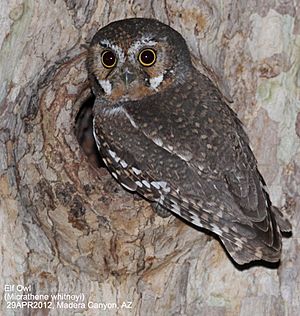Elf owl facts for kids
Quick facts for kids Elf owl |
|
|---|---|
 |
|
| Conservation status | |
| Scientific classification | |
| Genus: |
Micrathene
|
| Species: |
whitneyi
|
 |
|
The elf owl (Micrathene whitneyi) is a tiny grayish-brown bird. It's about the size of a sparrow! You can find these owls in the Southwestern United States, central Mexico, and the Baja California peninsula. They have pale yellow eyes with thin white "eyebrows" and a gray beak. Elf owls often live in holes made by woodpeckers in saguaro cacti. They also nest in natural tree holes. These owls are active at night and mostly eat insects.
Contents
Raising Young: Elf Owl Reproduction
Elf owls usually pick old woodpecker holes in saguaro cacti, sycamores, cottonwoods, and other trees to raise their babies. They like a bare hole and sometimes even remove plants from inside. While they mostly use natural spots, they've also been seen nesting in man-made places like telephone poles in cities. This might help them as cities grow bigger.
Elf owls usually stay together for about three months to mate. During this time, the female makes special calls, and the male does his own mating dances. Both parents hunt for food on their own, but the male often brings food to the female while she stays near their chosen nest.
Females usually lay three eggs, but they can lay anywhere from one to five. This happens in springtime, from late March to early May. The eggs are round or oval, white, and about 2.5 to 3 centimeters long. The eggs hatch after about 24 days. The young owls, called owlets, are ready to fly on their own after about 10 weeks. They usually hatch in mid-June or early July and are ready to leave by the end of July.
After the owlets hatch, the female stays in the nest to watch over them. The male often hunts for both the young and the female. He does most of the feeding for the babies himself. This shared parenting usually lasts until the owlets are about 17 to 21 days old.
What Elf Owls Look Like and How They Behave
The elf owl is the lightest owl in the world. It's also the smallest owl! These tiny owls weigh about 40 grams (1.4 ounces). They are about 12.5 to 14.5 centimeters (5 to 5.7 inches) long. Their wings can spread about 27 centimeters (10.6 inches) wide. Their long flight feathers almost reach past their tail. They have pretty long legs and often look a bit bow-legged.
You can often find them in chaparral areas, especially during their breeding season. Elf owls are most active at dusk (when the sun sets) and just before dawn (when the sun rises). You can often hear them calling to each other right after sunset. Their calls sound like a high-pitched whinny or chuckle, with 5-7 notes that repeat quickly, like a young puppy.
Male and female elf owls have different calls. Males have more complex songs. They have "Class A" songs, which are 5-15 notes long. These songs are used to mark their territory and to tell females they are nearby. They also have "Class B" songs, which are their main mating calls.
Elf owls hunt mostly at night. They often fly in a straight line to catch insects. When they are near their nest or flying to a perch, they might fly in an arc. They live in cacti because the plants offer shade and a good climate.
When an elf owl is caught, it might pretend to be dead. This trick encourages a predator to loosen its grip, giving the owl a chance to escape. Elf owls are also very protective of their territory. The male sets up the territory, and both the male and female defend it. Males also protect their chosen female. They often use their songs to defend their space. During breeding season, elf owls stay in pairs. But when they migrate or chase away predators, they can be found in small groups. Other birds like jays, hawks, and bigger owls sometimes hunt young and adult elf owls.
Traveling South: Elf Owl Migration
Elf owls are known to migrate in large groups. Their travel patterns can change depending on where they live. Some elf owls fly to the southwest United States, like California, Arizona, New Mexico, and Texas, in the spring and summer to breed. In the winter, they fly to central and southern Mexico. These migrating owls return north in mid-April to early May. Some elf owl groups live in south-central Mexico and along the Baja peninsula all year round.
What Elf Owls Eat
Elf owls mainly eat insects and other small creatures like moths, crickets, scorpions, centipedes, and beetles. Plants like agaves and ocotillos are great places for them to hunt because moths and other insects can be found in their flowers. In cities, they sometimes hunt near outdoor lights that attract bugs. They are often seen chasing flying insects, similar to how a tyrant flycatcher hunts.
They also eat scorpions. After catching a scorpion, they carefully remove the stinger before eating it. Elf owls don't seem to be bothered by scorpion stings! Sometimes, they will also eat small mammals, reptiles, and other birds.
How Long Elf Owls Live
Elf owls usually live for 3 to 6 years in the wild. If they are kept in zoos or special care, they might live up to 10 years. The most common reasons they die are being hunted by other animals, bad weather, and competition with other owls.
Different Kinds of Elf Owls: Subspecies
Scientists recognize a few different types, or subspecies, of elf owls:
- M. w. graysoni (now extinct)
- M. w. idonea
- M. w. sanfordi
- M. w. whitneyi
The M. w. idonea subspecies lives in southern Texas to central Mexico all year. The M. w. sanfordi lives only in southern Baja California. The M. w. graysoni, also called the Socorro elf owl, lived on Socorro Island. This type of elf owl sadly became extinct around 1970.
Protecting Elf Owls: Conservation Status
The number of elf owls has been going down in recent years. This is because they are losing their natural homes, especially in the desert areas of California. Human activities, like moving water and building homes, have destroyed these desert and riverside areas. Also, new plants that don't belong there, like the salt cedar, are taking over. When their homes are destroyed, many elf owls can't find places to nest, hunt, or have babies in places like California and Arizona.
Even though elf owls are not considered in danger worldwide, they are listed as "endangered" in California. This is because there are fewer than 150,000 individual owls there. California has started a program to breed them in captivity to help increase their numbers. Many groups are also working to protect their desert and riverside homes.
Elf Owls in Stories
An elf owl named Gylfie is a main character in the Guardians of Ga'Hoole book series by Kathryn Lasky. Gylfie also appears in the 2010 movie based on the books. An elf owl also plays a big part in the book The Elf Owl and Imagined Amenities by Sam Biondo.
See also
 In Spanish: Mochuelo de los saguaros para niños
In Spanish: Mochuelo de los saguaros para niños


